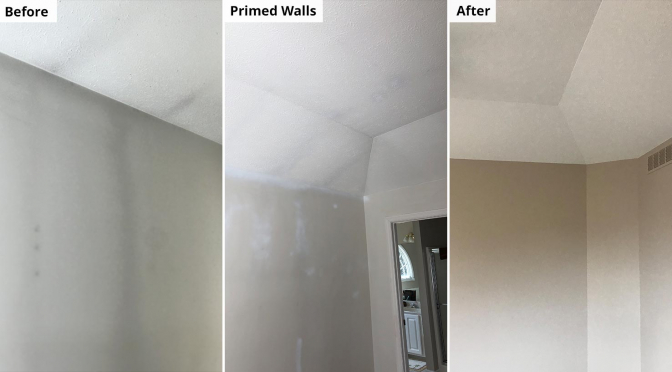Answers to paint pros’ most pressing questions by Rick Watson, Ask Your ProPartner™ columnist for PPC magazine. This time: Rick relates his own experience to answer a question about black spots on walls and ceiling.
A customer’s home has black spots on the wall and ceiling. They look like they follow the rafter and stud walls. Plus, those same black spots show up on the nail and screw heads. What is this, and how do we fix it?
Some call this micro-condensation, ghosting, soot (residue from burning candles or natural gas heat), or even mold.
Before you do anything, the first step is to check to see if this is a mold issue.
Is it mold or dirt?
Bleach tests are the typical test to check for mold.
Mold and mildew may be removed before painting by washing with a solution of one part liquid bleach and three parts water. Apply the solution and scrub the mildewed area. Allow the solution to remain on the surface for 10 minutes. Rinse thoroughly with water and allow the surface to dry before painting.
PRO TIP: Wear protective eyewear, waterproof gloves, and protective clothing. Quickly wash off any of the mixture that comes in contact with your skin. Do not add detergents or ammonia to the bleach-water solution.
There are two potential outcomes:
- If the bleach solution does not turn the spot white, then in all likelihood it’s not mold.
- If the bleach solution does turn the spots white and remove them, then in all likelihood it’s mold.
If it’s not mold
If mold is not present, the problem is mostly likely dust, dirt or soot.
The solution here is to clean the dirty areas with a good household cleaner degreaser and warm water before repainting.
If it’s mold
I suggest working with a specialty contractor to help remediate the mold and to stop moisture from entering the walls and ceilings.
Why does this occur?
First, it could be the difference in cold exterior air meeting up with warm moist air inside and ghosting on studs and rafters where insulation is lacking – especially on the interior of an outside wall or ceiling.
These areas tend to be moister than the insulated stud wall areas/cavity.
(Most often this is simply water vapor, not running water that you can see.)
Dirt and soot tend to collect where the condensation resides. Over time, these areas attract and build up airborne particles. To help fix this problem, I suggest working with an insulation company to figure out the best course of action.
Another scenario could be that there is too little moisture in the area. When an area is heated, the air coming out of the vents is usually dry air. Buildup of static electricity charges the dust and dirt particles and can cause them to stick to walls and ceilings.
I recently had to fix a dirt/dust/soot problem like this in my own home (see photos at top of story). I did the bleach test first on a few of the areas. The black spots did not turn white or go away so I knew that mold was not the issue.
To prep the surface for repainting, I cleaned the dirty areas with a cleaner/ degreaser and warm water, then rinsed.
Next, I sanded the walls and trim and primed all the areas that had been spotted with a good stain-blocking primer. My choice was PrepRite® ProBlock® Interior Oil-Based Primer. Besides blocking stains, it dries quickly and assures a uniform finish.
For the topcoat, I used SuperPaint® Interior Acrylic with Air Purifying Technology on the ceiling, Emerald® Interior Acrylic Latex Matte (two coats) on the walls, and Emerald® Urethane Trim Enamel Semi-Gloss on all trim and doors.
I also used Sher-Max® Urethanized Elastomeric Sealant around the ceiling areas and trim work.
PRO TIP: The Sher-Max Sealant provides excellent flexibility, adhesion and performance. Plus, by using this sealant on my project, it made the finish look more uniform and professional.
Final thoughts
After I finished the job, I naturally had to ask myself how this could have happened. Smoke, gas furnaces, propane and fireplaces are all potential sources. In my case, 22 years of not painting the room, plus gas heat, burning candles and not cleaning the walls caused my problem.
Will this happen again? It very well could if I’m not diligent. I think I will not wait 22 years again to repaint.
Surface prep safety notes
Warning! Removal of old paint by sanding, scraping or other means may generate dust or fumes that contain lead. Exposure to lead dust or fumes may cause brain damage or other adverse health effects, especially in children or pregnant women. Controlling exposure to lead or other hazardous substances requires the use of proper protective equipment, such as a properly fitted respirator (NIOSH approved) and proper containment and cleanup. For more information, call the National Lead Information Center at 1-800-424-LEAD (in US) or contact your local health authority.
This article was originally published in the Fall 2021 of PPC magazine. Rick Watson is director of Product Information and Technical Services at Sherwin-Williams. He answers reader questions about products, application and paint technology in the Ask Your ProPartner™ column in PPC magazine.

